Las Médulas is located between Lugo and León in the northern part of Spain. Las Médulas is a dramatic landscape, shaped by human intervention and natural processes. Las Médulas was the most important gold mine in the Roman Empire. The opencast mining or Ruina Montium was one of the mining systems used by the Romans. By this system the Romans mined the gold-rich soil with tunnels and shifts. Water was conducted through the tunnels acting as an explosive, resulting in the collapsing of the mountain. After the collapse, water was used to conduct the gold-rich mud to the washing canals. Ruina Montium caused the formation of a dramatic landscape with caves such as La Cuevona, the Huge Cave, and Cueva La Encantada, the Enchanted Cave. Today, the red mountains of Las Médulas are covered by wild flowers, oaks and sweet chestnut trees. Las Médulas is situated along the Ruta de la Plata, the Silver Route, an ancient Roman road from Mérida in the south to Astorga in the north. Las Médulas is situated close to Ponferrada, a town along the Way of St. James to Santiago de Compostela. Las Médulas was declared a UNESCO World Heritage in 1997.
www.werelderfgoedfotos.nl © Copyright World Heritage Photos Classic Car Road Trip
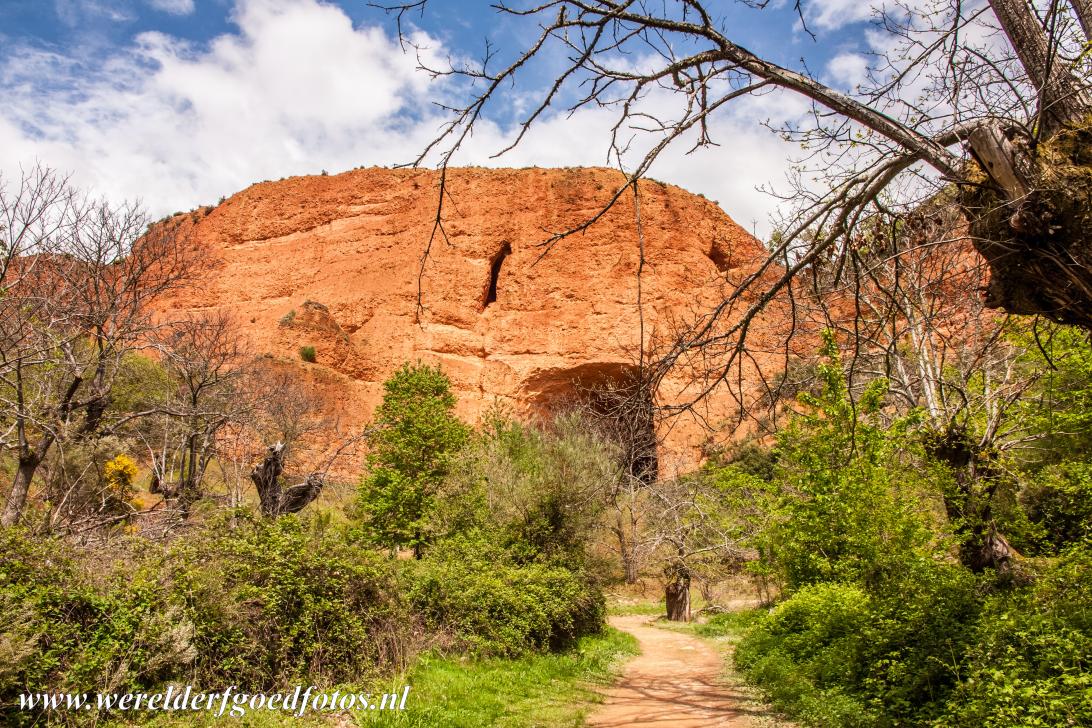
La Cuevona, the Huge Cave, of Las Médulas. The unique and dramatic landscape of Las Médulas was shaped by a Roman gold mining technique in the first and second centuries AD. The Roman author and army commander Pliny the Elder, a procurator in this region in 74 AD, described the gold mining technique, Ruina Montium. The intriguing reddish-brown landscape of Las Médulas was declared a UNESCO World Heritage in 1997.

La Cuevona, the Huge Cave, of Las Médulas. The unique and dramatic landscape of Las Médulas was shaped by a Roman gold mining technique in the first and second centuries AD. The Roman author and army commander Pliny the Elder, a procurator in this region in 74 AD, described the gold mining technique, Ruina Montium. The intriguing reddish-brown landscape of Las Médulas was declared a UNESCO World Heritage in 1997.
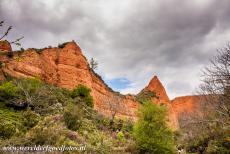
Las Médulas was the most important gold mine in the Roman Empire. The mining started in the first century AD, when Spain was under Roman rule. About 20,000 Roman pounds of gold were extracted from the mine in Las Medulas every year. The Roman pound, the libra, was approx. 327.45 grams. About 60,000 labourers were involved in the gold mining, the majority of them were slaves and forced labourers.
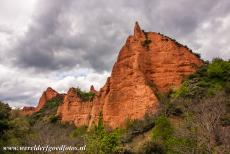
Las Médulas: The opencast mining or Ruina Montium was one of the mining techniques used by the Romans. By this technique they mined the gold-rich soil with tunnels and shifts. Water was conducted through them acting as an explosive, causing the collapse of the mountains. After the collapse, water was used to conduct the gold-rich mud to the washing canals.
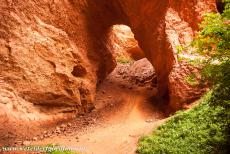
Las Médulas: The red sandstone caves of La Cueva Encantada, the Enchanted Cave. The Ruina Montium caused the formation of a dramatic landscape with caves and a maze of underground tunnels such as La Cuevona and La Cueva Encantada. For the Ruina Montium a large network of canals was constructed to supply water to the gold mine. Las Medulas is located in the valley of the Sil River.
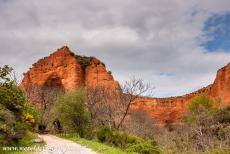
Las Médulas: The Ruina Montium caused the formation of a dramatic and unrealistic landscape with many caves such as La Cuevona, the Huge Cave, and La Cueva Encantada, the Enchanted Cave. The mine of Las Médulas was the most important gold mine in the entire Roman Empire. The gold mine was exploited until the beginning of the third century. Las Médulas is nowadays a nature reserve, one of the most unique in Spain.
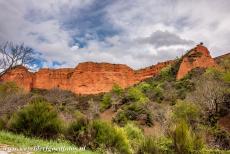
Las Médulas: The mining in Las Médulas ceased in the 3th century when the supply of gold was exhausted. Today, the destroyed red mountains are covered with wildflowers, oaks and sweet chestnut trees. Las Médulas is rich in wildlife such as wild boar, deer and wild cats. Las Médulas is also home to around hundred bird species, among them birds of prey and songbirds. Notable bird species in Las Médulas are the Barbary partridge and the Iberian shrike..
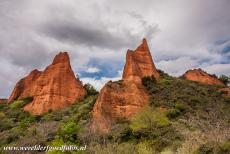
Las Médulas is located in Spain, about 25 km from the town of Ponferrada, the capital city of the isolated El Bierzo region. The El Bierzo region is situated on the pilgrimage route to Santiago de Compostela, also known as the Way of St. James, one of the most famous Christian pilgrimage routes. Las Médulas is one of the best preserved Roman mining areas in the world. Las Médulas was inscribed on the UNESCO World Heritage List in 1997.
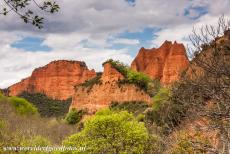
Las Médulas: Opencast mining or Ruina Montium was one of the mining systems used by the Romans. The result is a dramatic landscape that was shaped by human intervention and natural processes. Las Médulas is situted along Ruta de la Plata, the Silver Route, an ancient commercial Roman road, it runs from Augusta Emerita, modern Mérida, in the south to Astorga in the north.
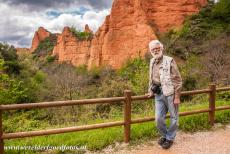
A visitor to the UNESCO World Heritage Las Médulas. The imposing landscape of Las Médulas is characterized by red sandstone rocks overgrown with numerous wild flowers, shrubs, oak and sweet chestnut trees. Sweet chestnuts are a delicacy in Spain, especially in the provinces of León and Castile. Visitors are not allowed to pick and eat the sweet chestnuts or take them away. The Senda de las Valiñas is a walking route in Las Médulas, the circular route is about 4 km long.
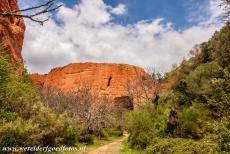
Las Médulas: The entrance to La Cuevona, the Huge Cave, is the largest cave in the landscape of Las Médulas. After more than two centuries of gold mining the Romans departed and left here a devastated landscape with caves and underground galleries. For nearly two thousand years, the landscape has remained almost untouched. Las Médulas is now an intriguing and fairytale-like walking area.

A classic Mini, a 1974 Spanish-produced Mini Authi, is in Las Médulas during a road trip through Spain. After about two centuries of gold mining, the Romans abandoned Las Medulas, leaving the landscape to its current shape. Las Medulas is visited by more than two million tourists each year. The viewing point Orellán is located about eight kilometres from the small mountain town of Las Medulas, it offers one of the best panoramic views of the landscape of Las Médulas.
